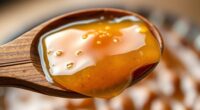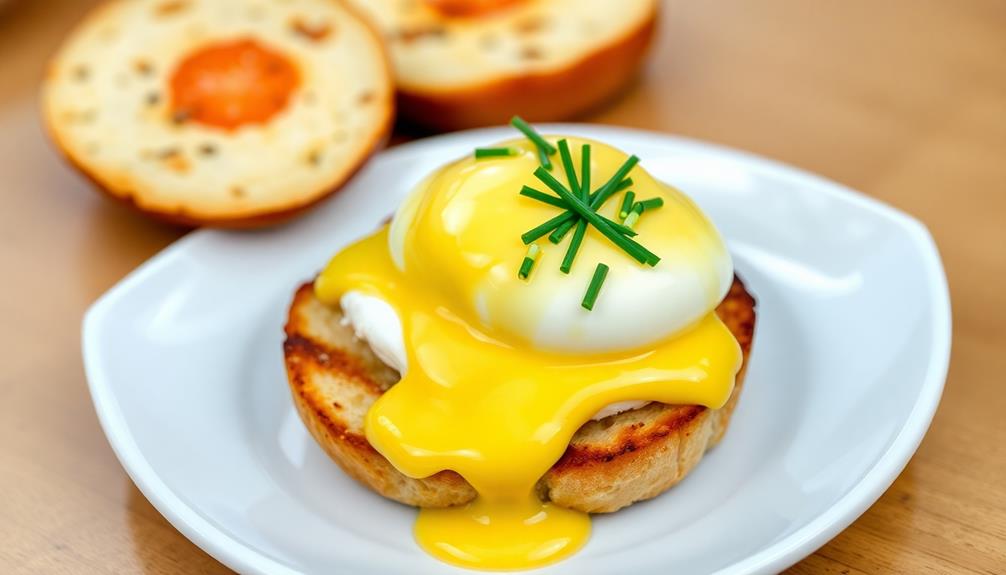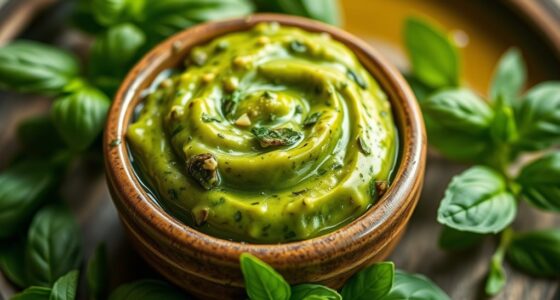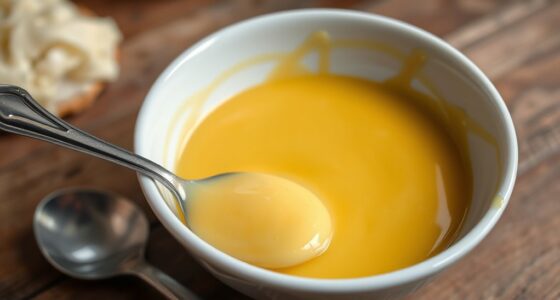To avoid splitting your beurre blanc, keep the reduction ratio between 1:1 and 1:2 of liquid to butter, ensuring enough liquid stabilizes the emulsion without overpowering it. Use gentle heat and add butter gradually while whisking constantly, keeping the temperature around 85°C. Monitoring these ratios, temperature, and techniques helps prevent breakage. If you keep these tips in mind, you’ll master a silky, stable sauce—more details ahead to help you perfect it.
Key Takeaways
- Maintain a reduction ratio of 1:1 to 1:2 (liquid to butter) for emulsion stability.
- Incorporate butter gradually, whisking continuously at low heat to prevent splitting.
- Control temperature carefully, keeping it around 85°C (185°F) to avoid overheating.
- Use small amounts of cold water to rescue a broken sauce and re-emulsify smoothly.
- Avoid rapid heating and overwhipping; stir steadily and keep ingredients chilled throughout.
Understanding the Role of Acid and Liquid in Beurre Blanc

Understanding the role of acid and liquid in beurre blanc is essential because they work together to create its signature texture and flavor. The acid, often from white wine and lemon juice, provides brightness and helps cut through rich dishes, making wine pairing easier and more harmonious. The liquid component, typically butter, is melted and emulsified to give beurre blanc its creamy consistency. Properly balancing the acid and liquid ensures the sauce remains stable without splitting. Too much acid can overpower delicate flavors, while too little may lack brightness. By mastering this balance, you enhance the sauce’s flavor profile and achieve a smooth, velvety texture that complements seafood, poultry, or vegetables. Additionally, understanding how the acidity influences the emulsion can help prevent the sauce from breaking during preparation, leading to a more successful outcome. This understanding is key to crafting a successful beurre blanc every time.
The Ideal Reduction Ratio for a Stable Emulsion

What is the key to achieving a stable beurre blanc emulsion? The ideal reduction ratio balances the liquid and fat to prevent separation while creating a rich, smooth sauce. Typically, a 1:1 to 1:2 ratio of reduced liquid to butter works best, ensuring enough liquid to stabilize the emulsion without overwhelming it. This ratio allows for flavor variations—adding herbs, citrus, or spices—without risking instability. Proper color temperature adjustments can also help maintain the sauce’s consistency and appearance. Serving suggestions include drizzling the sauce over seafood or vegetables, where its silkiness enhances the dish. Adjusting the reduction ratio slightly can tailor the sauce’s consistency and flavor profile, but sticking close to these proportions helps maintain stability. Mastering this balance ensures your beurre blanc remains luscious and split-free every time.
Techniques for Gentle Heating and Precise Temperature Control

Maintaining the right temperature during beurre blanc preparation guarantees your emulsion stays stable and smooth. To achieve this, use gentle heating techniques, such as double boiling or a warm water bath, to control heat precisely. This method helps prevent overheating that can cause splitting. Here are three tips to help you stay in control:
- Use a thermometer to monitor temperature constantly, aiming for around 85°C (185°F) for gentle simmering.
- Adjust heat gradually, avoiding direct high heat to prevent sudden temperature spikes.
- Incorporate marinade techniques by adding ingredients slowly, which helps with flavor balancing and prevents abrupt temperature changes.
Mastering these methods ensures your beurre blanc remains velvety and stable, making it easier to perfect your sauce without risking a split disaster. Remember, precise temperature control is essential for a successful emulsion.
Incorporating Butter: Timing and Method for Emulsification

To achieve a smooth beurre blanc, you should add the butter gradually while keeping the heat moderate. Keep whisking continuously to promote emulsification and prevent separation. By following these steps, you’ll guarantee a rich, velvety sauce every time.
Add Butter Gradually
Adding butter gradually is essential for creating a smooth, stable beurre blanc. You should add small pieces at a time, allowing each addition to emulsify fully before adding more. This prevents separation and ensures a glossy sauce. To master this, focus on:
- Using proper whisk techniques, maintaining a steady, gentle motion to incorporate butter evenly.
- Watching the temperature closely, keeping it moderate to avoid breaking the emulsion.
- Considering ingredient substitutions, like using clarified butter if you prefer a more stable sauce or if dairy sensitivities exist.
- Paying attention to the type of headphone jack used in your devices, as proper connections can ensure optimal audio quality during cooking podcasts or tutorials.
Maintain Moderate Heat
Keeping the heat moderate during the beurre blanc process is crucial for successful emulsification. Proper temperature control prevents the sauce from splitting and ensures a smooth, velvety texture. Too high heat causes the butter to break down, leading to separation, while too low heat hampers emulsification. Maintain a gentle simmer, adjusting the heat as needed to keep the mixture just below boiling. This steady temperature helps you balance flavors effectively, preventing bitterness or loss of delicate notes. Consistent heat allows the butter to incorporate smoothly, creating a cohesive sauce. Remember, patience and control are key to achieving the perfect beurre blanc—flavor balancing depends on maintaining that moderate temperature throughout the process. Using temperature regulation techniques can further enhance your success in emulsification.
Whisk Continuously
Once you’ve maintained a steady, moderate heat, focus on whisking the sauce constantly as you incorporate the butter. Whisk continuously to create a smooth, stable emulsion and prevent overheating, which can cause the sauce to split. Keep these tips in mind:
- Add small pieces of butter gradually, whisking constantly to allow proper emulsification.
- Maintain steady, gentle movements to avoid breaking the emulsion.
- Watch the heat carefully, ensuring it stays moderate to prevent overheating and separation.
- Consistent stability throughout the process is key to achieving a perfectly balanced beurre blanc.
Common Mistakes That Lead to Splitting and How to Avoid Them

Splitting in beurre blanc often occurs when the sauce is heated too quickly or at too high a temperature. To prevent this, avoid overwhipping cream, which can destabilize the emulsion, and don’t use metallic utensils that may react with the sauce’s acidity. Rapid heating causes the emulsion to break, leading to separation. Use gentle heat and stir constantly. Here’s a quick guide:
| Mistake | Cause | Solution |
|---|---|---|
| Overwhipping cream | Emulsification failure | Whip gently and add gradually |
| Using metallic utensils | Chemical reaction with acid | Use wooden or silicone tools |
| Heating too fast | Sudden temperature change | Warm slowly, stirring consistently |
| Not monitoring temperature | Overheating the sauce | Use a thermometer, keep low heat |
Troubleshooting Tips for Fixing a Broken Beurre Blanc

When your beurre blanc breaks, try emulsifying it slowly by whisking constantly. Adding a small splash of cold water can help bring the sauce back together. Keep these techniques in mind to salvage your sauce quickly and effectively. For best results, maintain a consistent emulsification process to prevent separation in future attempts.
Emulsify Slowly
If your beurre blanc starts to break, try emulsifying it slowly rather than rushing the process. Rapid mixing can cause the sauce to split further. To prevent this, chill ingredients beforehand to keep everything stable and prevent overheating. When emulsifying, follow these steps:
- Gradually add small amounts of warm liquid, stirring constantly.
- Keep the heat low and maintain a gentle, steady motion.
- If the sauce begins to break, remove it from heat and whisk in a few drops of cold water or chilled ingredients to help re-emulsify.
Taking your time allows fats and liquids to blend smoothly. Emulsify slowly to avoid overheating, which can destabilize the emulsion, and always keep ingredients chilled for better control.
Use Cold Water
Adding cold water is a simple yet effective way to rescue a beurre blanc that has started to break. When your sauce separates, carefully whisk in a small amount of cold water. This helps stabilize the emulsion by encouraging the fat and liquid to recombine. Use emulsification techniques like whisking vigorously to incorporate the cold water smoothly. Be cautious not to add too much at once, as this can cause the sauce to thin out or become too watery. Cold water acts as a shock, helping to bring the broken sauce back together without overthinning. Keep stirring steadily until the sauce regains its creamy, glossy consistency. Incorporating AI-driven techniques can also help monitor and adjust the sauce’s texture in real-time, preventing it from breaking in the first place. This quick fix can save your sauce and prevent it from becoming irreparably broken.
Frequently Asked Questions
How Does Altitude Affect Beurre Blanc Reduction Ratios?
Altitude affects beurre blanc reduction ratios because lower air pressure causes liquids to evaporate faster, requiring an altitude adjustment. You should reduce the heat slightly and monitor reduction timing closely to prevent over-thickening or splitting. By adjusting your timing and heat, you maintain the proper ratio, ensuring a smooth, emulsified sauce. Keep an eye on the sauce’s consistency, and don’t rush the reduction process at higher altitudes.
Can Alternative Acids Be Used Without Risking Splitting?
Did you know that vinegar variations and lemon substitutes can affect beurre blanc’s stability? You can use these alternatives without risking splitting, but you need to adjust the ratio carefully. For example, lemon juice is more delicate than vinegar, so use less to prevent curdling. Always taste and add acids gradually, stirring constantly, to keep your sauce smooth and emulsified, ensuring a perfect, split-free beurre blanc.
What Are the Signs of an Unstable Beurre Blanc During Cooking?
When cooking beurre blanc, you’ll notice signs of instability like emulsion separation or curdling, which indicate the sauce is breaking. Keep an eye on temperature fluctuations, as sudden changes can cause the emulsion to split. If the sauce starts to look greasy or separates into layers, it’s a clear sign it’s becoming unstable. To prevent this, maintain gentle heat and stir consistently to keep the emulsion intact.
How Long Can Beurre Blanc Be Kept Before It Separates?
Imagine your beurre blanc as a delicate soap bubble—once it bursts, it’s chaos. You should store it in the fridge for no more than 1-2 days, tightly covered, to prevent separation. Refrigeration tips include stirring before use and avoiding reheating at high temperatures. Beyond this window, it’s prone to splitting, turning your culinary masterpiece into a greasy mess. So, enjoy it fresh—your sauce will thank you.
Does the Type of Butter Influence the Emulsion Stability?
You might wonder if the type of butter affects emulsion stability. Yes, butter quality matters; higher-fat, fresh butters tend to create more stable emulsions. Using proper emulsion techniques, like gradually incorporating cold butter and maintaining consistent heat, also helps prevent splitting. Cheaper or lower-quality butters with inconsistent fat content can destabilize the sauce, making it more prone to separation. So, choose good butter and follow correct techniques for best results.
Conclusion
Mastering beurre blanc is like tending a delicate flame—you need patience, attention, and a gentle touch. When you control the heat and respect the balance of acid and butter, your sauce flows smoothly, much like a calm river reflecting a clear sky. Avoid rushing the process, and you’ll create a silky, stable emulsion that elevates your dish. With practice, you’ll turn simple ingredients into a harmonious symphony of flavor, never fearing the split disaster again.










